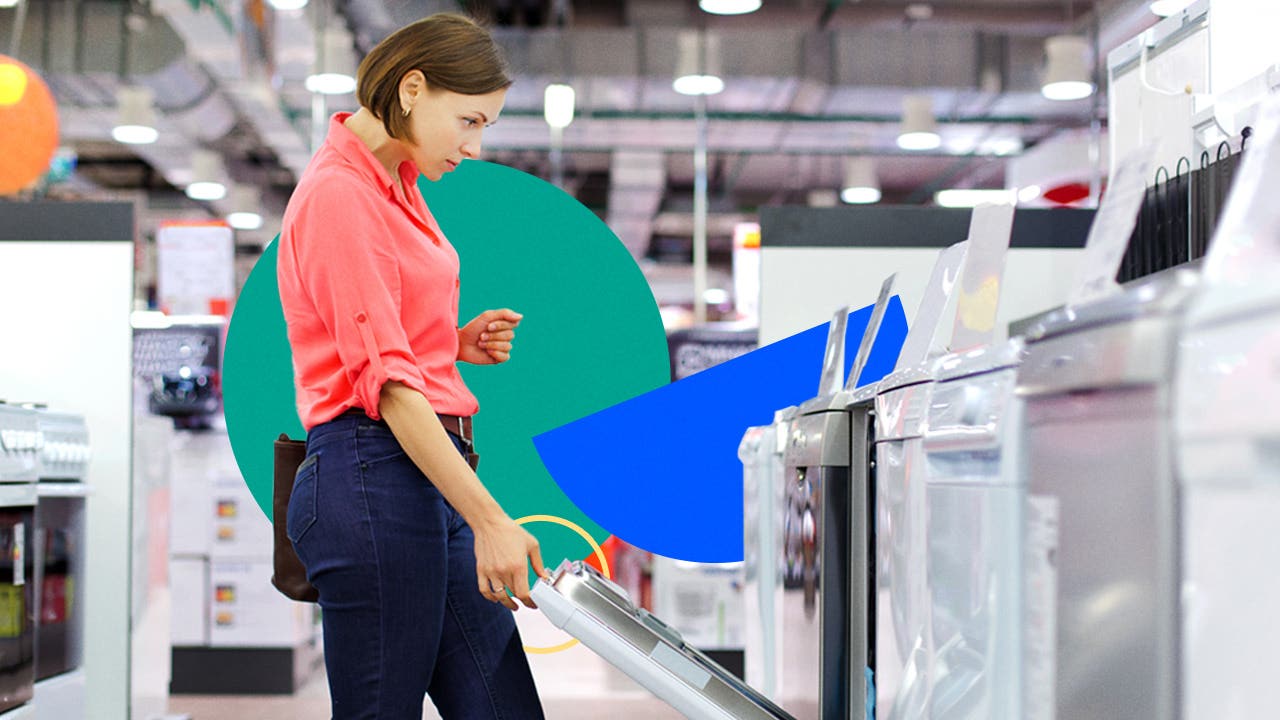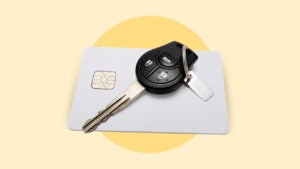When to use credit cards for large purchases

Key takeaways
- You could consider using a credit card for large purchases if you can pay off the balance before it starts accruing interest. A 0 percent introductory APR card buys you more time to pay off the purchase.
- Using a credit card to pay for large but predictable expenses — like groceries, travel and appliances — can help you earn rewards and access additional benefits.
- It’s also possible to pay for big expenses with alternative options like a savings fund, personal loan or BNPL (buy now, pay later) plan.
Say you’re remodeling your home, footing the bill for a big trip or facing an emergency expense. The money has to come from somewhere, and you might be wondering whether you should swipe a credit card to pay for it.
You can consider using a credit card for large purchases, but there’s a chance of racking up interest fees and impacting your credit score. Half of Americans carry credit card debt from month to month, according to Bankrate’s Credit Card Debt Survey, but that doesn’t mean it’s a good idea to pay interest on a large purchase. That’s where a card with 0 percent intro APR could come in handy.
Whether you go for an intro APR option or high-earning rewards card for a big expense will depend on how you use the card and when you can pay off the balance.
Learn more about when to use — or not to use — a credit card for large purchases.
Benefits of using a credit card for a large purchase
If you’re thinking of putting a high-dollar charge on your card, it helps to weigh the pros and cons. Here are a few reasons why using a credit card for a large purchase may work in your favor.
Sign-up bonus
Some rewards credit cards offer lucrative sign-up bonuses — often in the form of cash back, points or miles — to new cardholders. To earn the bonus, you typically have to spend a certain amount within the first few months. If you already need to make a big purchase and have your eye on a new credit card, it might be a good opportunity to meet your minimum spending requirement and earn any welcome bonuses it offers.
Learn more: Here are our picks for the best credit card sign-up bonuses.
0 percent intro APR
A new credit card with a 0 percent introductory APR offer might be a good choice for a large purchase. You’ll still need to make minimum payments each month. If you don’t, your issuer may revoke the introductory rate and you’ll be charged the regular interest rate. But this strategy may give you more than a year to chip away at a big credit card balance.
Rewards
If you have a rewards card, you might be able to tap into a flat-rate, tiered or rotating spending category to earn cash on a big expense. Or, you could earn points or miles to put toward your next vacation. Earning rewards on a large purchase you need to make anyway can help maximize your credit card rewards strategy. Just remember, earning rewards isn’t a reason to go into debt. Racking up rewards on a large credit card purchase should only be a consideration if you know you can pay off the purchase without incurring interest charges.
Card benefits
In addition to rewards, credit cards may offer additional perks that can help protect or enhance your purchase.
For example, extended warranty protection could help if you’re buying a new appliance. Travel insurance and free checked bags might come in handy on that big trip. And purchase protection can make sure you’re covered if your new smartphone is stolen.
Buy now, pay later
Credit cards are increasingly offering a buy now, pay later option for large purchases. Instead of paying off the whole purchase in one billing cycle, you may be able to make several monthly payments.
In most cases, the issuer charges interest fees for a buy now, pay later option, but it’s often a fixed and lower rate than regular credit card interest. And while it can be helpful to spread out a hefty payment over time, it’s still a form of debt. Make sure you can afford the monthly payments.
Emergency help
If you’re facing an emergency and need to cover immediate expenses, using a credit card may be your best — or only — option. You could consider applying for a new 0 percent intro APR credit card with a long introductory period. You’ll want to make at least the minimum payment each month. But make sure you know when the period ends so you won’t be surprised by the regular APR. Ideally, you’d pay your balance off by then to avoid interest charges.
It might help to reach out to a credit counselor for more advice on minimizing debt while paying for emergencies.
Risks of using a credit card for a large purchase
While it might be tempting to swipe your card for a big-ticket item, think twice if you won’t be able to pay off the balance at the end of the billing cycle. Here are a few risks to consider.
Interest fees
It’s not a good idea to spend beyond your means — and if you’re not able to pay off your credit card balance, interest fees can add up quickly. Since the average credit card interest rate is quite high, currently around 20 percent, it’s ideal to only use your credit card for purchases you can pay off at the end of the billing cycle.
Plus, carrying a balance can affect your credit score.
Credit score impact
Another factor that affects your credit score is your credit utilization ratio. Credit utilization compares how much credit you’re using to how much available credit you have. Experts recommend keeping your credit utilization below 30 percent.
If you make a big purchase on a credit card, it may bring you close to your credit limit. And unless you pay off the balance quickly, it could negatively impact your credit score.
How to plan for a large credit card purchase
If you’re planning for a big purchase on a 0 percent intro card, you can calculate how long it will take to pay it off without incurring interest charges.
Consider this example: Your refrigerator is on its last legs, and you find a quality replacement for $1,500. You apply for a credit card offering a 0 percent intro APR for one year and make your purchase. You’ll want to divide the purchase price ($1,500) by the number of interest-free months on your card (12). In this case, you’d need to pay at least $125 each month to avoid paying interest after the intro APR period ends.
If you won’t be able to repay the balance within the interest-free period, it’s probably best to avoid charging a major expense to your credit card. Even if your card has a relatively low APR, those interest charges will compound and lead to more debt.
If you’re making a large purchase on a credit card to score rewards or get a sign-up bonus, you can still run the numbers to make sure you can afford to pay the balance off as soon as possible.
If you don’t want to apply for a new credit card — or would rather earn rewards with your current card — you can try working a big purchase into your budget. Last month, I bought new ski boots for $400, so I planned ahead to deduct that money from my typical monthly spending for dining out and shopping. That way, I still had enough of my income left at the end of the month to pay off my card balance.
That may sound simple, but several years ago, I would’ve just pulled from my savings to pay off the balance instead. A budget helps you plan for expenses, rather than letting expenses happen to you.
Common large purchases to make with a credit card
Sometimes, it makes sense to put a large purchase on a credit card — especially if you’ve run the numbers and are able to pay it off quickly. Here are a few of those scenarios:
- Groceries. Trips to the grocery store add up quickly, especially if you have a lot of mouths to feed. Groceries are an ongoing expense you could charge to a credit card that rewards you for grocery store purchases. Here are our picks for the best credit cards for groceries.
- Appliances and electronics. Household appliances and electronics can come with a hefty price tag. But some credit cards offer added protections and benefits to help with that big purchase. For example, purchase protection can cover items bought with your credit card for a specific amount of time, typically within 90 to 120 days. If the item is damaged or stolen, you could get a reimbursement or replacement. Read your credit card’s terms and conditions to understand any limitations.
- Travel. Travel expenses like flights, lodging and rental cars can help you earn miles and points with a travel credit card. And those rewards can be put toward your next trip. Depending on your credit card, you may have access to benefits like trip cancellation insurance, luggage protection and rental car insurance.
Alternatives to credit cards
Credit cards aren’t the only option for making a big purchase. Consider these alternatives:
- Make a savings plan. If you’re able to predict a future big purchase, you could set aside a certain amount each month that will help you save the right amount of money by the right time. A high-yield savings account — with current rates averaging 4.64 percent — can help you earn interest as you save.
- Apply for a personal installment loan. A personal loan allows you to borrow money up front and make fixed payments — or installments — later. You can usually use a personal loan to pay for many types of things, like a wedding, medical bills or debt consolidation. And with good credit, you might be able to get a better rate on a personal loan than your credit card.
- Use a retailer’s buy now, pay later option. While some credit cards offer this form of payment, so, too, do some retailers — by partnering with buy now, pay later companies like Affirm, Afterpay, Klarna, PayPal Credit and Zip. If you’re buying a pricey item from a retailer, you may be able to get a payment plan without a credit check or interest fees. Just make sure you can afford the monthly payments, and read the fine print of the agreement.
- Take out a home equity line of credit (HELOC). If you’re a homeowner, you could borrow against your home equity to pay for a number of things, like home improvement, your kids’ college tuition or another big bill. A HELOC uses your home as collateral, which means it’s critical to pay off the loan on time. It may come with tax advantages and a better interest rate than other loan types.
- Set aside your income tax refund. If you’re expecting a tax refund, you could dedicate it to a big expense instead of just adding it to your bank account. This can soften the impact on your regular spending and budget.
The bottom line
Using a credit card for large purchases could be a good option if you can still make your payments on time and in full. Otherwise, you might face compounding interest charges and a hit to your credit. There may be other ways to pay for big-ticket items or bills, like creating a savings account or taking out a loan. However you plan to pay for the purchase, it’s a good idea to crunch the numbers and figure out an achievable repayment plan.
If you think a credit card is your best bet, check out Bankrate’s best credit cards for large purchases.






